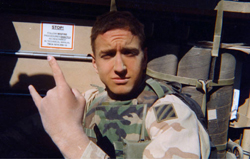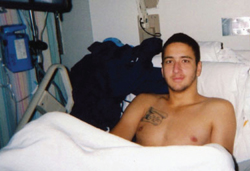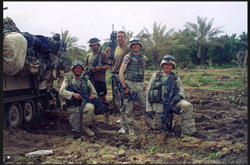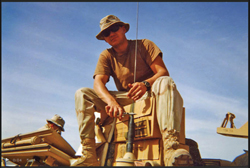A Soldier's Story
Most people would have called it a war, but just three months later, Stewart was back with his battalion, on active duty. To get there, he would undergo a rehabilitation stint at Walter Reed Army Medical Center that would be chronicled on the front pages of the Washington Post and mount a challenge that would ultimately rewrite the Army rulebook. And he would also strike up a friendship with New York Times political cartoonist Jeff Danziger that would lead him to attend Columbia University on the GI Bill, and that has now brought him to Teachers College to prepare for life as a social studies teacher.
“I was told that I recovered from my injury the fastest they’d ever seen,” says Stewart, whose boyish, bespectacled mien is belied by his 6-foot-5-inch, 200-plus pound frame. “I’ve taken a lot of trips back to Walter Reed since to visit the newly wounded, and it feels really good to be able to tell them, ‘Look, you can do whatever you want. You can go back and do the job. I did it. If you don’t want to go back, I’ve already gone to college and here is how I used my benefits.’ They just light up. They see the light at the end of the tunnel. It makes a big difference and that means a lot to me.”
Stewart grew up in Stillwater, Minnesota, a hamlet of some 15,000 people on the banks of the St. Croix River. It was there that he decided after graduating from Stillwater Area High School to enlist in the Army—some two months before the 9/11 attacks. By 2003, as the threat of war grew more ominous by the day, he was living in a tent in the big sandy of southern Kuwait, where temperatures would soar above 130 degrees by day and come sundown his unit would drill until 3 a.m. “I enjoyed it; it was fun,” he says almost wistfully. “Operation Desert Spring was honestly fun.”
The fun and games would soon come to end, however, when Stewart’s unit was among the first wave of American soldiers to cross the Iraqi border. The mission—or “planned final objective” in military speak—of his platoon of 30 men was to make it to a highway cloverleaf in south Baghdad. All of their maps ended at that one spot, the pot of gold at the end of their rainbow.
After a pitched fire fight, Stewart and his platoon made it to that final objective in early April and secured the road. “All we were doing was sorting through captured weapons and processing prisoners,” he says. “Me and a friend were walking on a road toward an anti-aircraft bunker and—Bam!—I stepped on that land mine.”
In a split second, the explosive ripped through his foot and sent his life careening on a journey he could hardly have imagined. His wound would become infected with Acinetobacter bacteria, which thrives in the fertile soil along the Tigris and Euphrates rivers, and in order to rid his body of the infection, Army doctors would have to amputate four times—in each case inching nearer to his left knee.
He spent three weeks at Walter Reed, where the morphine essentially brought his digestive system to a screeching halt. He couldn’t even hold down water and spent a week hooked up to an IV. “I just threw up all day long.”
To make matters worse, during an epidural, his doctor punctured his spine, causing a leak of cerebral spinal fluid that resulted in what is known as a spinal headache—a head-throbbing, mind-numbing, migraine-like pain.
If his first two weeks at Walter Reed were hell, the final one was infinitely better. After his last surgery, Stewart told his doctors he was getting off Dilaudid no matter the pain, and his body began to recover. That same week, U.S. Senator Daniel Inouye, who had himself lost an arm in World War II as a member of the 442nd Regiment—a unit made up of Japanese Americans who fought so bravely and well that it became the most decorated in U.S. military history—walked up to Stewart’s bedside and asked him if he could pin his Purple Heart on him.
“I said I’d be honored and stood up on one leg, and he pinned on my Purple Heart with his one hand,” Stewart says. “And then right behind him, Hulk Hogan came by to say hello. I told Hulk Hogan that he was my hero when I was a kid, and he told me, ‘Well, you’re my hero now, brother.’ I was on Cloud Nine that day.”
Two days later, looking gaunt at just 156 pounds, Stewart left Walter Reed for good.
For soldiers who lose a limb, the pattern is always the same: the military issues an honorable discharge, and they venture off to make a life for themselves outside the uniform. In fact, in 2003, it was against Army regulations for an amputee to serve in the infantry. Stewart, however, was set on returning to his battalion—amputation or not.
He simply out-willed the Army bureaucracy. With the aid of a prosthesis (these days he wears the latest and greatest, the Bioquest Freedom Foot), he passed the Army’s physical training test, re-qualified on his rifle and mortar, and somehow managed to attend the Army’s National Training Center for Desert Warfare. He simply would not take no for answer, and he eventually made it back to his battalion, rejoining his buddies at Fort Benning in Georgia—and in so doing helped change Army regulation.
“Think about it this way: If you get injured, you gotta
prove to yourself that you can still do what you were doing at the time of the
injury,” he says. “I needed to do that. So that was very satisfying for me.
There were two things I was worried about in the hospital bed, and it was
athletic prowess, Was I ever going to be strong again? and then vanity, What
would girls think? I found out the first weekend I was home that women are very
forgiving about that sort of thing. So I quit worrying about that. And then as
far as athletics goes, I went back to the Army.”
Having proven he could do it, Stewart left the service in
late 2004, but not before dashing off a fan letter to Danziger, whose anthology
Wreckage Begins with ‘W’ struck a chord. Danziger by turn invited
Stewart to New York to stay with him and his wife and visit local colleges.
Stewart took him up on the offer, and the moment he walked onto the Columbia
campus, he knew it was the place for him.
His experience at Columbia was great, he says. He fit right in, so much so that some of his friends don’t even know that he had served in the military or that he wears a prosthetic foot. And those who do know have simply expressed interest, curious about his experiences and the on-the-ground realities of war in Iraq.
But Stewart concedes that there were a few run-ins over the
years, namely with members of the Columbia chapter of the International
Socialist Organization. “They were protesting the war, and I walked up to them
and told them I was a veteran and tried to tell them some of the things they
were saying weren’t correct,” he says. “I just wanted to tell them, ‘Look, I
was there, and no, I never ate a baby, and I seriously did do my best to help
the average Iraqi.’ Well, they weren’t interested in that kind of a story. They
thought it was ridiculous, and they thought I was a racist.
In May, he graduated from Columbia’s
School of General Studies with a degree in history. By then, however, he’d already decided his next move: attending
Teachers College. He says he has harbored the desire to teach since his days in
high school in Stillwater, where he was, admittedly, a rather modest student.
“One thing I like about an education career is the idea of getting paid to
talk. That’s pretty irresistible. I can talk all day.”
There was never any question where he would pursue his graduate education. In fact, he even spoke about his desire to attend TC when he made an appearance (his second) on journalist Anderson Cooper’s program on CNN in October of 2008. (While on the air, Stewart asked Cooper for a letter of recommendation.)
When it came time to apply, Stewart tapped his expanding network of friends and acquaintances for those letters of recommendation. And the letters came—from the likes of former Defense Secretary and World Bank President Paul Wolfowitz, U.S. Rep. Charles Rangel, essayist Christopher Hitchens, and, yes, Cooper himself.
These days, Stewart is looking forward to immersing himself in his studies at TC and earning his degree in the Teaching of Social Studies. “I’m here to cut my teeth,” he says. “I’m going to student teach in New York City. If I can teach here, I can teach anywhere.”
Even so, he remains unsure whether he’ll enter the classroom right after graduation. He’s weighing the idea of tapping what’s left of his military benefits to pursue a law degree, and maybe—given his gift for gab—give a political career a shot. “I like attention and like I said before, I like to talk.”
Regardless, it’s been a good life, he says, and whatever he has been through is what it is. No regrets.
“I’ll tell you what, I would give up my leg for Columbia,” he says. “I don’t think there is any other way I would have gotten to go to Columbia. My parents are actually dirt poor, and I grew up on welfare. So there is no way I ever would have gone to a school like Columbia unless I had that government funding. And as it turns out, I’m a smart kid and had the brains to get through school, but the money had to come from somewhere. People have asked me, ‘If you could go back in time, would you still walk down that road?’ The answer is yes.”
To read the transcript of Stewart’s appearance on CNN, go to http://transcripts.cnn.com/transcripts/0810/25/acd.01.html.
To view a story about Stewart that aired on CBS News, go to www.youtube.com/watch?v=4MX3I2vXnwI.
To view the Washington Post stories, go to
http://www.washingtonpost.com/wp-dyn/articles/A16510-2003Jul19.htmlPublished Monday, Aug. 24, 2009





